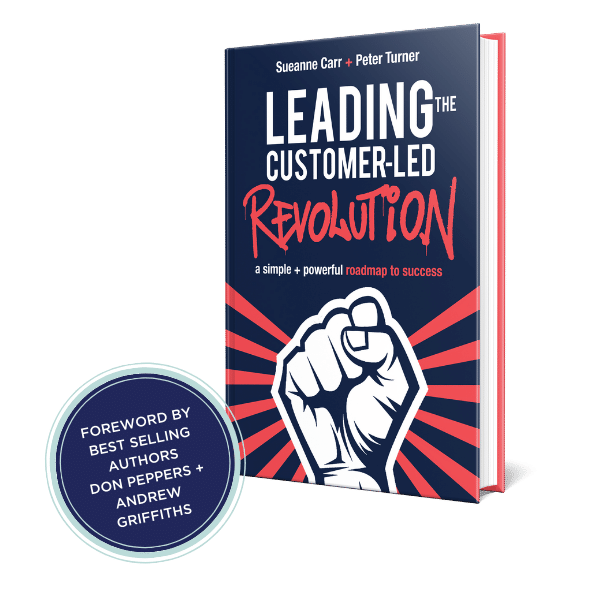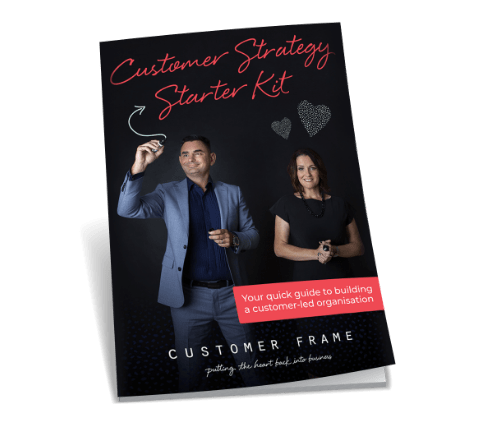You have a finance strategy, right? You have a marketing strategy. You likely have a people + culture strategy. + a technology strategy.
But for the ultimate reason you exist – your customer –
do you have a strategy?
A customer strategy is a carefully planned approach that organisations adopt to attract, engage, + retain their customers. It involves understanding customer needs, aligning business goals with those needs, + implementing tactics to deliver a superior customer experience.
Without a well-defined customer strategy, companies risk losing market share, failing to meet customer expectations, + falling behind their competitors. So, the question is, do you have a customer strategy?
Check out below for six ways to develop an effective customer strategy.
Building out a robust Customer Strategy is one of the foundations for the customer-led organisation.
We cover off this + more in our new book ‘Leading the Customer-led Revolution’.
Grab your copy here.

6 Ways to Develop your Customer Strategy
1. Understanding Your Customers
The foundation of any effective customer strategy lies in a deep understanding of your target customers. This goes beyond simple demographic information + requires a holistic understanding of their preferences, pain points, behaviours, + aspirations. By conducting thorough market research, analysing customer data, + leveraging customer feedback, you can gain valuable insights into what drives your customers’ decisions + how you can meet their needs more effectively.
2. Segmentation + Targeting
Once you have a clear understanding of your customers, the next step is to segment them into distinct groups based on their characteristics + needs. Segmentation allows you to identify specific customer segments that are most valuable to your business + tailor your marketing efforts accordingly. By targeting the right customer segments, you can focus your resources + efforts on those who are most likely to be interested in your products or services, increasing the effectiveness of your marketing campaigns + optimising your return on investment.
3. Building Customer Relationships
Building strong + lasting relationships with your customers is a fundamental aspect of any customer strategy. This involves creating positive touchpoints at every stage of the customer journey, from initial awareness + consideration to purchase + post-sales support. By delivering exceptional customer service, personalised experiences, + timely communication, you can foster loyalty + advocacy among your customer base.
4. Innovation + Differentiation
A robust customer strategy also involves a focus on innovation + differentiation. In today’s fast-paced world, customer expectations are constantly evolving, + organisations need to stay ahead of the curve to remain competitive. By continuously innovating + adapting your products, services, + processes, you can differentiate yourself from competitors + provide unique value propositions that resonate with your customers. This can be achieved through ongoing market research, gathering customer feedback, + fostering a culture of innovation within your organisation.
5. Measuring + Improving Customer Satisfaction
To gauge the effectiveness of your customer strategy, it is crucial to establish metrics + measure customer satisfaction regularly. This can be done through surveys, feedback forms, + customer reviews. By monitoring key performance indicators such as customer retention rate, customer lifetime value, + Net Promoter Score (NPS), you can assess how well your customer strategy is performing + identify areas for improvement. Continuous improvement based on customer feedback + data analysis is essential for staying competitive + meeting evolving customer expectations.
6. The Power of Technology
In today’s digital age, technology plays a vital role in implementing + optimising a customer strategy. Customer relationship management (CRM) systems, data analytics tools, + marketing automation platforms can provide valuable insights + streamline customer interactions. Leveraging emerging technologies such as artificial intelligence, chatbots, + personalised recommendation engines can further enhance the customer experience + drive customer satisfaction.
In conclusion, having a well-defined customer strategy is essential for businesses striving to succeed in today’s competitive marketplace.
Customers are the ultimate reason you exist,+ they need an organisation-level strategy, just for them.
By understanding your customers, segmenting + targeting effectively, building strong relationships, fostering innovation, + leveraging technology, you can create a customer-centric organisation that delivers exceptional value + experiences.
Investing in a customer strategy is not only a means to gain a competitive advantage but also a way to build long-term customer loyalty + drive sustainable business growth.
So, ask yourself again, do you have a customer strategy? + if not, why not!
Building out a robust Customer Strategy is one of the foundations for the customer-led organisation.
We cover off this + more in our new book ‘Leading the Customer-led Revolution’.
Grab your copy here.






